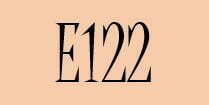What is E 122 additive?
The food additive E122- azorubine, is a red synthetic azo dye. It can also be found under the name carmoisine or cardinal 3B. Azorubine is prepared by the coupling reaction between diazonium salt and a coupling component which is 4-hydroxy-1-naphthalene sulphonic acid (Neville-Winter acid). It is obtained synthetically from α-naphthylamino-4-sulfonic acid diazo and α-naphthol-4-sulfonic acid[1]
Which foods contain the food additive E 122?
The food additive E 122, can be found in the following products:
– flavoured melted cheese,
– dried fruit and vegetables, in canned red vegetables,
– fruit and vegetables in vinegar, oil or brine, in canned red vegetables,
– canned fruit and vegetables in tins or jars, canned red vegetables,
– fruit and vegetable preparations, except compotes, canned red vegetables,
– chewing gum,
– decorations, coatings and fillings,
– processed fish and fishery products, including molluscs and crustaceans, only fish paste and crustacean paste, only semi-processed crustaceans,
– aromatised wine-based products as defined in Regulation (EEC) No 160/91,
Read too:E551 – Silicon dioxide
– wine-based flavoured drinks.[2]
Are there any side effects from consuming the food additive E 122?
Because it is an azo dye, azorubine can create intolerance in people intolerant to salicylates. It is a histamine releaser, and can intensify asthma symptoms. In combination with benzoates (E 210-215 may promote hyperactivity in children (ADHD syndrome).[3]
Azorubine may cause allergic phenomena and/or intolerance reactions similar to those caused by aspirin, such as digestive irritation with dyspeptic disorders, rash, itching, bronchospasm (especially in asthmatics), dizziness, headache, nausea, etc. There are also cases where pronounced water retention in tissues has been observed.
There is no evidence that Azorubine induces tumour formation. Various neoplastic lesions have been observed after feeding Azorubine to mice and rats.
In some carcinogenicity studies in rats and mice, histopathological examination indicated that Azorubine was not associated with the incidence of any type of tumour. It has been observed that reported adrenal histopathological changes are quite common in aged laboratory rats and, in addition, these lesions generally vary considerably between different studies. Therefore, the group concluded that these adrenal histopathological changes are not toxicologically relevant, which was in line with the previous evaluation of these data by JECFA and SCF.
Read too:E950 Acesulfame K
A study by McCann et al. (2007) concluded that exposure to a diet with two mixtures of four synthetic dyes, including Azorubine, plus a sodium benzoate preservative, led to increased hyperactivity in 3- to 9-year-old children. In an earlier study by the same research team, there was some evidence for effects of a mixture of four synthetic colours (including Azorubine) and sodium benzoate in 3-year-old children. (Bateman et al., 2004).
In a reproduction study, 2 groups of rats (25/sex/group) received 0 to 1% azorubine in their drinking water (equivalent to 0-500 mg/kg bw/day) for 6 months. Weight gain, mortality and general condition were similar in both groups. After 7 months the animals were mated to produce the F1 generation. After weaning, F1 offspring also received 1% Azorubine and after 4 months were mated to produce an F2 generation. No abnormalities in brood numbers or fertility were observed. The F2 generation also received 1% Azorubine for 200 days and were subsequently maintained on normal diet and water for 2 years. No adverse effects on mortality or tumour incidence were observed (Hecht, 1966). [4]
What are the characteristics of E 122 additive?
Azorubine consists essentially of disodium 4-hydroxy-3-(4-sulfonato-1-naphthylazo) naphthalene-1-sulfonate and subsidiary colouring matters together with sodium chloride and/or sodium sulfate as the principal uncoloured components.
Azorubine is described as sodium salt. Calcium and potassium salts are also permitted.
Chemical name 4-hydroxy-3-(4-sulfonato-1-naphthylazo) naphthalene-1-disodium sulfonate
Chemical formula C20 H12 N2Na2 O7 S 2
Molecular weight: 502.44
Read too:E202 – Potassium sorbate
Assay: Contains not less than 85% total colouring matters calculated as sodium salt
Description: red to brown powder or granules
Appearance of the aqueous solution: Red
Identify
Spectrometry Maximum in water at ca. 516 nm
Purity: Water insoluble matter Not more than 0,2 % Purity: Water insoluble matter
Auxiliary colouring matters Not more than 1 % Not more than 1
Read too:E407 – Caragenan
Organic compounds other than dyestuffs:
– 4-aminonaphthalene-1-sulfonic acid and 4-hydroxynaphthalene-1-sulfonic acid: in total not more than 0,5%.
– Unsulfonated primary aromatic amines: Not more than 0,01 % (calculated as aniline)
– Ether extractable substances: Not more than 0,2 % in neutral medium
Arsenic: Not more than 3 mg/kg
Plumb: Not more than 2 mg/kg
Mercury: Not more than 1 mg/kg
Cadmium: Not more than 1 mg/kg.[5]
The acceptable daily intake for human consumption of azorubine is up to 4 mg/kg body weight, which is very low and can easily be exceeded.
Intake dose in food: 100-500 mg/kg 100-200mg/l.
Read too:E 211 – Sodium Benzoate
Description of use children: Not permitted in foods intended for infants and young children.
What are food colours?
Colours are substances that add or restore colour to foods and include natural components of food or other natural substances that are not usually consumed as foods in their own right and are not usually used as characteristic ingredients in food. Preparations obtained from foodstuffs and other natural edible raw materials obtained by physical and/or chemical extraction leading to a selective extraction of pigments in relation to nutritive or aromatic constituents are also considered as colours.[6]
When is the use of food colours acceptable?
The use of food colours is considered acceptable for the following purposes:
- restoring the original appearance of food whose colour has been altered by processing, storage, packaging and distribution;
- improving the visual attractiveness of food products;
- colouring of foodstuffs that are normally colourless.
The use of food colours must always respect the general condition of not misleading the consumer. For example, the use of colours must not give the impression that it contains ingredients that have never been added.[7]
How do we know that foods contain food additives?
According to the World Health Organization, practices, standards and guidelines on food labelling are established globally. These standards are implemented in most countries and food manufacturers are obliged to indicate which additives are in their products. In the European Union, for example, there is legislation governing the labelling of food additives according to a set of pre-defined “E-numbers”. People with allergies or sensitivities to certain food additives should read labels carefully.
Read too:E415 – Xanthan Gum
The World Health Organization encourages national authorities to monitor and ensure that food additives in foods and beverages produced in their countries comply with the uses, conditions and legislation.
What are food additives?
According to World Health Organization[8] , substances that are added to food to maintain or improve the safety, freshness, taste, texture or appearance of food are known as food additives. For centuries, food additives have been used to preserve food, for example salt (in meat, bacon or dried fish), sugar (in marmalade) or sulphur dioxide (in wine).
Over the years, many food additives have been developed to meet the needs of food production, because large-scale food manufacturing is much more complex than small-scale home production.
Introducing additives into food is done to ensure that processed foods remain safe and in good condition throughout their journey from factories or industrial kitchens to warehouses and shops and ultimately to consumers.
The use of food additives is only justified when their use has a technological need, does not mislead consumers and serves a well-defined technological function such as preserving the nutritional quality of food or enhancing the stability of food.
Read too:E129 – Alura AC
Food additives can be derived from plants, animals or minerals, or they can be synthetic. They are intentionally added to food to fulfil certain technological purposes. There are several thousand food additives in use, all of which are designed to perform a specific task, usually to make food more durable or appealing.
Conclusions and Legislative Regulations E 122
Additive E 122 – azorubine colours foodstuffs in which it is incorporated red (to brownish red).
It is necessary in restoring their natural colour, degraded during processing, storage, or transport. As with other colours, E122 also has the role of colouring food products lacking colour to make them more attractive.
Part of Group III: Food colours with a combined maximum level, depending on the food into which they are incorporated.[9]
Azorubine (E 122) is an azo dye permitted as a food additive in the EU and previously evaluated by JECFA in 1983 and SCF in 1984. Both committees established an ADI of 0-4 mg/kg bw/day.
Author: dr.ing. Ancuta Fulvia Manolache
Bibliographical references
[1] Elena Oranescu, Food Additives-necessity and risk, SemnE Publishing House, 2005, Bucharest
[2] Commission Regulation (EU) No 1129/2011 of 11 November 2011 amending Annex II to Regulation (EC) No 1333/2008 of the European Parliament and of the Council by establishing a Union list of food additives
[3] http://www.food-info.net/ro/e/e122.htm
[4] Re-evaluation of Azorubine/Carmoisine (E 122) as a food additive , SCIENTIFIC OPINION Scientific Opinion on the re-evaluation of Azorubine/Carmoisine (E 122) as a food additive1 EFSA Panel on Food Additives and Nutrient Sources added to Food (ANS)2, 3 European Food Safety Authority (EFSA), Parma, Italy, EFSA Journal 2009; 7(11):1332
[5] COMMISSION REGULATION (EU) No 231/2012 of 9 March 2012 laying down specifications for food additives listed in Annexes II and III to Regulation (EC) No 1333/2008 of the European Parliament and of the Council
[6] http://insp.gov.ro/download/cnmrmc/Ghiduri/Igiena%20Alimentatiei%20si%20Nutritiei/Ghid-Aditivi-Alimentari.pdf
[7] http://www.ansvsa.ro/informatii-pentru-public/sanatate-publica/
[8] https://www.who.int/news-room/fact-sheets/detail/food-additives
[9] http://old.ms.ro/documente/REGULAMENTUL%20UE%20NR.%201129%20-%202011%20AL%20COMISIEI_2934_7616.pdf
9 https://pixabay.com/ro/photos/sos-ro%c8%99ie-conserve-busuioc-5514235


